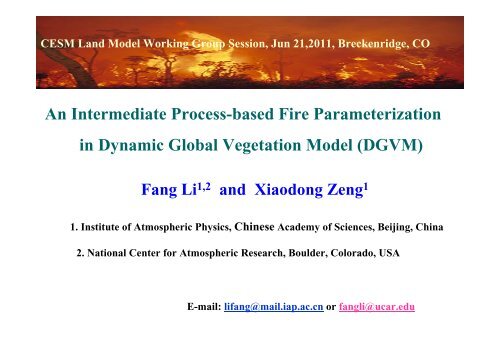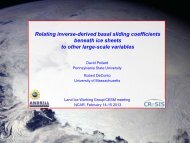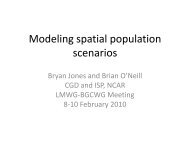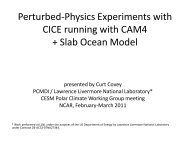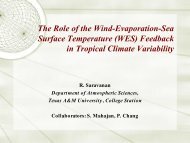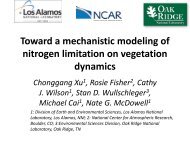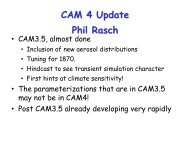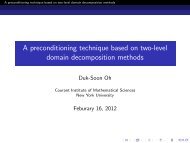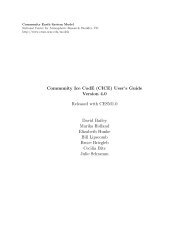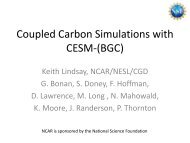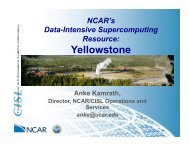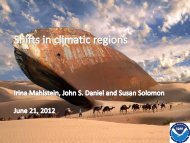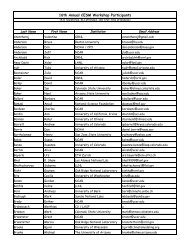Fang Li - CESM
Fang Li - CESM
Fang Li - CESM
Create successful ePaper yourself
Turn your PDF publications into a flip-book with our unique Google optimized e-Paper software.
<strong>CESM</strong> Land Model Working Group Session, Jun 21,2011, Breckenridge, CO<br />
An Intermediate Process-based Fire Parameterization<br />
in Dynamic Global Vegetation Model (DGVM)<br />
<strong>Fang</strong> <strong>Li</strong> 1,2 and Xiaodong Zeng 1<br />
1. Institute of Atmospheric Physics, Chinese Academy of Sciences, Beijing, China<br />
2. National Center for Atmospheric Research, Boulder, Colorado, USA<br />
E-mail: lifang@mail.iap.ac.cn or fangli@ucar.edu
Background<br />
• Importance of the fire in the earth system<br />
– For vegetation: without fire, closed forests would double (27% to 56%) of<br />
vegetated grid cells for 20 th century simulated by SDGVM (Bond et al. 2004).<br />
Tree cover fire off Tree cover fire on<br />
– For C/N cycle: biomass burning emits ~ 2.1PgC/yr with large interannual<br />
variability (1.4 - 3.2PgC/yr) from 1960 to 2009 (Schultz et al., 2008; Van der Werf et al. 2010)<br />
Ref: 1980-2004 mean global net land-to-atmosphere carbon flux: ~ -0.7 PgC/yr (IPCC 2007)<br />
– For climate:<br />
• fire →vegetation, C/N cycle →climate<br />
• Biomass burning → abundant greenhouse gases, over 40% of global black<br />
carbon, ~30% of global CCN →climate (Day, 2004; Arora and Boer, 2005,Andreae et al.,<br />
2004; <strong>Li</strong>ndsey and Fromm, 2008)
• Fire parameterization schemes in current DGVMs<br />
can be divided into three types:<br />
– constant fire loss rate/simple statistical model: those in<br />
TRIFFID, ED, VEGAS, SDGVM, and IBIS<br />
– complex process-based: SPITFIRE in LPJ-SPITFIRE and<br />
MCFIRE in MCDGVM<br />
– intermediate process-based : Glob-FIRM in LPJ, SEIB-<br />
DGVM, CLM3.0-DGVM, ORCHIDEE, CoLM-DGVM, and CLM4.0-<br />
CNDV, and CTEM-FIRE in CTEM<br />
It can capture the major processes of fire dynamics with efficient computation
Motivation and object<br />
• Existing intermediate process-based fire parameterizations have some<br />
shortcomings:<br />
–Glob-FIRM: not take into account<br />
• Availability of ignition sources<br />
• Impact of wind speed on fire spread<br />
• Combustion incompleteness of plant tissues in the post-fire region<br />
–CTEM-FIRE:<br />
• Constant probability of human-caused ignition and cloud-to-ground lightning<br />
fraction (0.5 and 0.25, globally)<br />
• self-inconsistent estimation scheme of burned area<br />
• framework of fire occurrence part →underestimate burned area in tropical<br />
savanna.<br />
• Object :<br />
to develop an intermediate process-based fire parameterization, which<br />
overcomes the above listed shortcomings
Fire parameterization<br />
It comprises three parts: fire occurrence, fire spread, and fire impact<br />
Ignition point<br />
Fire occurrence Fire spread Fire impact<br />
Time-step: hourly or daily<br />
daily, monthly,<br />
annually
lightning<br />
frequency<br />
ignition<br />
sources<br />
Fire<br />
Occurrence<br />
population<br />
density<br />
anthropogenic<br />
fire suppression<br />
Its Wire Diagram<br />
Fire counts<br />
vegetation<br />
characteristics<br />
fuel load<br />
Fire<br />
Impact<br />
relative humidity<br />
soil moisture<br />
fuel<br />
combustibility<br />
average duration<br />
of a fire<br />
burned area<br />
fraction<br />
post-fire<br />
mortality<br />
Adjustment<br />
of C pools<br />
wind speed<br />
spread rate<br />
of a fire<br />
Fire<br />
Spread<br />
biomass<br />
combustion<br />
trace gas and<br />
aerosol emissions
Model platform and Data<br />
• Model platform: CLM-DGVM<br />
CLM3.0-DGVM ( Levis et al. 2004) modified by Zeng et al. (2008) and Zeng (2010)<br />
• Data<br />
•spin-up: 880 years<br />
with repetition of 55<br />
years (1950-2004)<br />
forcing data<br />
•Evaluation period:<br />
1997-2004 (common<br />
years for GFEDv3<br />
and forcing data)
Results (1997-2004) : Burned area<br />
Mod-new: new fire parameterization<br />
Glob-FIRM: Thonicke et al. 2001<br />
Mod-old: old fire parameterization in CLM-DGVM (Levis et al. 2004)<br />
380<br />
324<br />
54<br />
93<br />
•Cor: global spatial correlation<br />
between sim and obs<br />
• Mod-new is good agreement with observations, and more skillful than Glob-FIRM and<br />
Mod-old.<br />
• Ref: 1997-2004 CLM-CN simulations with CTEM-FIRE (300Mha/yr, Cor=0.19) and its<br />
revised version (182Mha/yr, Cor=0.52) (Kloster et al. 2010)
• Fire Carbon emissions<br />
•Mod-new has more<br />
accurate global gross<br />
(GFCE) and spatial<br />
distribution than Glob-<br />
FIRM and Mod-old<br />
•Fire carbon emission<br />
/burned area (CA, TgC<br />
/Mha):<br />
GFEDv3: 5.5<br />
Mod-new: 5.9<br />
Glob-FIRM: 64.8<br />
Mod-old: 35.5<br />
• Ref: 1997-2004 CLM-CN simulations with CTEM-FIRE (Cor=0.25, GFCE=2.5PgC/yr,<br />
CA=8.5 TgC/Mha) andits revised version (Cor=0.45, GFCE=2.0PgC/yr, CA=9.8TgC/yr)<br />
(Kloster et al. 2010)
• Aerosol and trace gas emissions due to fire<br />
• Mod-new is good<br />
agreement with GFEDv3<br />
product for all types of<br />
trace gases and aerosols<br />
emissions<br />
•Average relative errors:<br />
6.02%.
Future plans<br />
•To test the fire parameterization in CLM4-CNDV after adding<br />
parameterization of impact of fires on nitrogen pools, and deforestation<br />
and cropland fires<br />
•To Investigate fire-vegetation-climate interaction on a global scale from<br />
an earth system perspective with <strong>CESM</strong> as model platform.<br />
Thank you !


